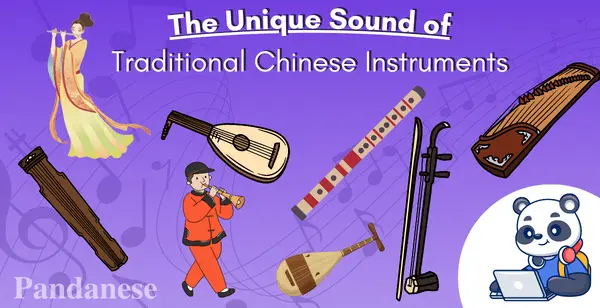
The Unique Sound of Traditional Chinese Instruments
Chinese traditional instruments have been played for thousands of years and are an integral part of Chinese culture, including religious ceremonies, court music, and entertainment.
Today, Chinese music is enjoyed by people worldwide, not just in China. Musicians from various countries incorporate Chinese instruments into their own style compositions, resulting in their performances being seen as a work of art and visual feasts. From the musicians' movements to the intricate hand gestures and the traditional outfit, all these add to the overall experience of watching a musical performance.
This article will look closely at some of the most popular Chinese musical instruments.
The history of traditional Chinese instruments
The earliest Chinese instruments were made from bones, stones, and bamboo. As Chinese society developed, so did its music and instruments.
During the ancient times of the Tang Dynasty (618-907), a new era of music and musical instruments emerged. Many of the traditional Chinese musical instruments we know today were invented and refined during this time. These instruments are not only unique in their designs but also in the sounds they produce.
The top 8 well-known Chinese traditional instruments
1. Chinese zither (Guzheng)

Guzheng, Guzheng Alive
The Chinese zither, or guzheng, is a plucked instrument with 21 strings. It has a long history in Chinese music and is often used in both solo and ensemble performances. In folk music, the guzheng often accompanies traditional singing, such as the "shan'ge" songs of the Shanxi province.
Song: Spring River Flower Moon Night played on the Guzheng by SoundofChina GuzhengThe sound of the Guzheng is often described as tranquil and soothing, with a range of tones and timbres that create a mesmerizing effect. The instrument is often used in Chinese classical music but has also made its way into modern pop music in recent years.
2. Chinese seven-stringed zither (Guqin)

Guqin by CGTN
Not to be confused with Guzheng, the guqin is a seven-stringed zither played in China for thousands of years. It is considered one of the most important Chinese traditional musical instruments. Although guzheng and guqin are relatively similar since both are fretless, the guqin does not have moveable bridges under each string.
The guqin has a long and narrow wooden body and is played by plucking its seven strings with the fingers.
Its sound is soft and delicate, and it is often associated with nature and meditation. In fact, it was once considered a tool for self-cultivation and was played by scholars and poets to achieve a sense of inner peace.
The theme song of Ashes of Love played on the guqin by Zi De guqin Studio
Guqin's long history has made it a symbol of Chinese tradition and wisdom, and it is often referred to as the "instrument of the sages." Despite its ancient roots, the guqin is still played today and is cherished by musicians and enthusiasts for its beautiful and tranquil sound.
3. Chinese violin (Erhu)

Grandfather teaching how to play erhu
The Chinese violin, or the erhu, is a two-stringed instrument played with a bow. It has a distinctive sound, often described as haunting or melancholic.
The erhu is sometimes compared to a human voice and is often used to imitate the sound of Chinese singing. This mimic is from the sliding sound of the instrument and can replicate the changes in pitch and tone that are characteristic of Chinese singing.
How erhu can imitate a human voice, Sek Huat Peh
The erhu is used in various music styles, from classical to contemporary. In Chinese folk music, the erhu is often used to accompany traditional singing, such as the "tea-picking" songs of the Yunnan province.
4. Chinese mandolin (Liuqin)

Liuqin by Wikimedia
The Liuqin is a small, pear-shaped stringed instrument popular in Chinese music.
This instrument has a short neck and four strings and is played with a plectrum. Its bright and cheerful sound makes it a popular choice for upbeat folk music.
Despite its small size, the Liuqin can produce a wide range of tones and is often used in ensembles with other Chinese musical and percussion instruments. Its versatility has made it popular in various musical genres, including traditional, pop, and rock music.
Someone playing The Spring of TianShan on the Liuqin, lwy1234
One interesting fact about the Liuqin is that it was originally used as an accompaniment for Beijing opera. However, over time, it became popular in other types of music, including pop and rock music. It is still widely used in traditional music and is often played in orchestras, ensembles, and solo performances.
5. Chinese transverse flute (Dizi)

Dizi by China Plus
The dizi is a bamboo instrument with six finger holes. It is one of the oldest Chinese instruments that has been played for thousands of years.
This instrument is used in various music styles, from classical to pop. Its bright and clear distinctive sound is played by blowing across the mouthpiece and using finger holes to change the pitch.
One unique aspect of the dizi is its membrane, also called a di mo, that covers one of the finger holes. This di mo gives the dizi a distinct buzzing sound, a characteristic of Chinese music.
Comparing the sounds of dizi with and without di mo, Eason Music Pte Ltd
One unique aspect of the dizi is its membrane, also called a di mo, that covers one of the finger holes. This di mo gives the dizi a distinct buzzing sound, a characteristic of Chinese music.
6. Chinese end-blown flute (Xiao)

Xiao by Eight Tones
It's a beautiful and unique instrument that was first believed to have existed among Qiang people who were shepherds. The Xiao has a long and fascinating history, as it's been said to be invented during the Han Dynasty.
The Chinese vertical end-blown flute is made of bamboo. It comes in eight different keys and is played by blowing across the end of the instrument. It has a mellow and soothing sound that is often used in Chinese classical music and meditation.
Traditional Chinese music played on the Xiao by Musical Moments - East
The Xiao is often used in Chinese opera and played solo or ensemble. It is so popular that a saying in China goes, "The sound of the Xiao is like a phoenix singing, and its melody can move even the immortals."
7. Chinese double-reed horn (Suona)

Suona by Sixth Tone
The suona has been a widely used traditional instrument since the 16th century.
It has a distinctively loud and brassy sound that can be heard over long distances. This instrument is played by blowing into a double reed mouthpiece and using the finger holes to change the pitch. The sound of the suona is often compared to a brass trumpet.
The suona is often used in Chinese weddings and funerals. At weddings, the suona is played during the procession to the bride's house and during the wedding banquet. In funerals, it is played to guide the deceased to the afterlife. The loud and penetrating sound of the suona is believed to help ward off evil spirits and bring good luck.
Suona being played at a Chinese funeral by West China Tea Company
Despite its long history and cultural significance, the suona might not be as well-known outside China as other traditional instruments. However, its unique sound and important role in China's culture make it a fascinating instrument.
8. Chinese lute (Pipa)

Pipa by WikiMedia Commons
The pipa, or Chinese lute, is another fascinating instrument with a rich history.
This four-stringed instrument is played using a plectrum and has been an integral part of Chinese music since the Qin Dynasty. The pipa is often used in solo performances. While in Chinese folk music, the Chinese lute is often used to accompany traditional storytelling, such as the "peking opera" of the Beijing region.
A Peking Opera Qupai Ensemble playing the Chinese lute, Ping Huey
Female musicians often play the pipa, as this instrument was historically associated with courtesans and female entertainers, who were admired for their beauty, intelligence, and musical talent. These women were considered cultural icons of their time, and their performances helped popularize the pipa and other Chinese musical instruments.
How are traditional instruments used in Chinese folk music?
In Chinese folk music, instruments are crucial in creating a unique and captivating sound. It is a diverse genre that includes various regional styles and reflects the Chinese people's customs, traditions, and beliefs.
Many traditional Chinese instruments, such as the erhu, are used in folk music. Some of the most famous examples of Chinese folk music include the "horse-head fiddle" music of Inner Mongolia and the "silk and bamboo" music of the Shanghai region.
Horse Head Fiddle being played by sliding up and down the string
Frequently asked questions
What are the 4 types of Chinese instruments?
There are 4 types of Chinese instruments: plucked strings instruments, bowed strings instruments, woodwinds instruments, and percussion instruments.
What are traditional instruments in China?
Guzheng, Guqin, Erhu, Liuqin, Dizi, Xiao, and the Pipa are some traditional instruments from China.
In closing
Chinese musical instruments hold a unique beauty that is truly captivating. The intricate designs, craftsmanship, and materials used in creating these instruments are a testament to the rich cultural heritage of China. They range some small instruments to full body sizes that can cover you. Moreover, the sounds these instruments produce are unlike any other, with each instrument having its unique voice and character.
From traditional performances to modern adaptations, the versatility and richness of Chinese musical culture are truly something to be appreciated.
Jing You is a Chinese native who grew up in the Fujian province and soaked in the Chinese culture while living with her grandparents. She later moved to Singapore to pursue further education. However, she has always been passionate about the Mandarin language despite being in an environment that speaks English predominantly. She was involved in multiple Mandarin and Chinese culture programmes in schools, and brought this passion forward by tutoring elementary school students Mandarin in her adulthood.
The easiest way to learn Chinese & build vocabulary

